In Hench Girl Comics, color schemes are essential for shaping the mood and visual impact of the narrative. By strategically using colors, creators can evoke specific emotions and alter readers’ perceptions of characters and storylines. The interplay of dark, gritty themes and light-hearted tones not only enhances storytelling but also enriches the overall reading experience, making it more immersive and engaging.
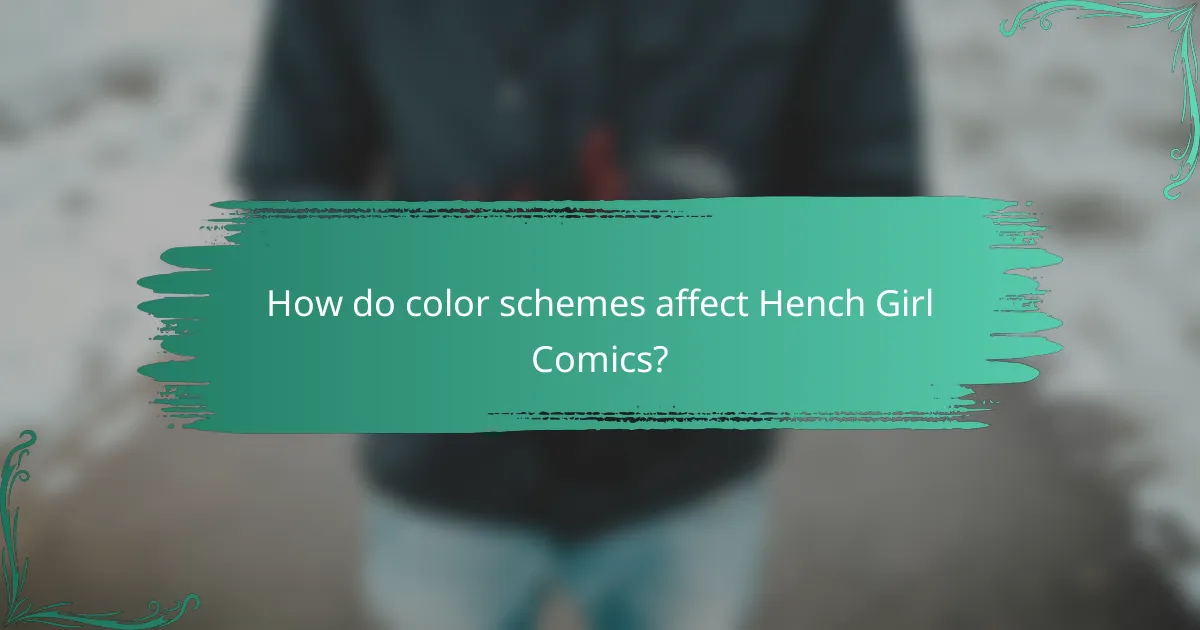
How do color schemes affect Hench Girl Comics?
Color schemes play a crucial role in Hench Girl Comics by influencing the mood, tone, and overall visual impact of the narrative. Different colors evoke specific emotions and can significantly alter how readers perceive characters and storylines.
Emotional responses to color
Colors can elicit strong emotional responses, impacting how readers connect with the characters and plot. For instance, warm colors like red and orange often convey excitement or aggression, while cooler tones like blue and green can evoke calmness or sadness.
Understanding these emotional triggers allows comic creators to strategically choose colors that align with the intended mood of a scene. For example, a tense confrontation might utilize stark contrasts with reds and blacks, while a lighthearted moment could feature soft pastels.
Color theory applications
Color theory provides a framework for selecting harmonious color schemes that enhance storytelling. Complementary colors, which are opposite each other on the color wheel, can create vibrant contrasts that draw attention to key elements, while analogous colors, which are next to each other, can produce a more cohesive and soothing effect.
Applying these principles can help artists create visual narratives that resonate with the audience. For example, using a triadic color scheme can add dynamism to action scenes, while monochromatic schemes can emphasize a character’s emotional state.
Examples from popular comics
Many successful Hench Girl Comics utilize color schemes effectively to enhance their storytelling. In “Henchgirl” by Kristen Gudsnuk, the use of bright colors reflects the quirky and humorous tone of the series, making it accessible and engaging for readers.
Conversely, in “Harley Quinn,” the contrasting color palette of vibrant pinks and dark blacks highlights the chaotic nature of the character and her world, reinforcing her unpredictable personality. These examples illustrate how thoughtful color choices can elevate the narrative and emotional depth of comics.
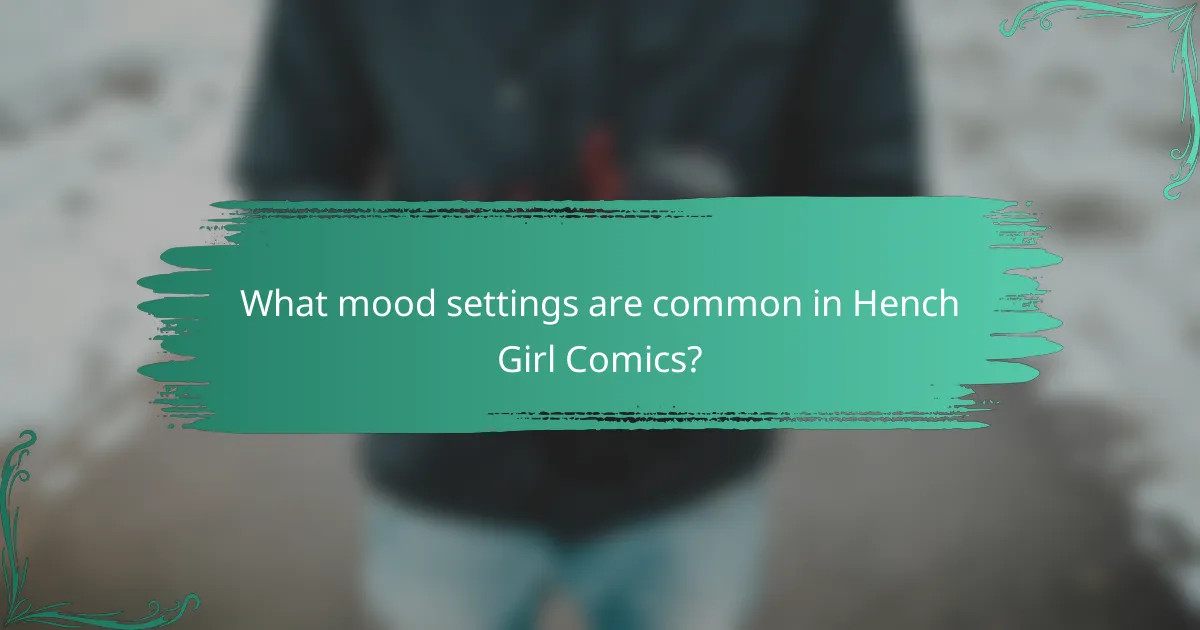
What mood settings are common in Hench Girl Comics?
Hench Girl Comics often feature a range of mood settings that significantly influence their storytelling and visual style. Common moods include dark and gritty themes, which create a sense of tension, and light-hearted, humorous tones that provide levity and entertainment.
Dark and gritty themes
Dark and gritty themes in Hench Girl Comics typically involve complex characters and morally ambiguous situations. These stories often explore the darker aspects of human nature, featuring anti-heroes and villains in a world filled with crime and betrayal.
Visual elements play a crucial role in establishing this mood. Artists often use muted color palettes, heavy shadows, and stark contrasts to evoke feelings of despair and tension. For example, a scene set in a dimly lit alley might utilize deep blues and blacks to enhance the foreboding atmosphere.
Light-hearted and humorous tones
In contrast, light-hearted and humorous tones focus on fun, quirky characters and absurd situations. These comics often employ slapstick humor and witty dialogue, making them accessible and enjoyable for a broad audience.
Bright colors and playful illustrations are essential in conveying this mood. Artists may use vibrant hues and exaggerated expressions to create a sense of joy and whimsy. For instance, a scene featuring a hench girl accidentally thwarting a villain’s plan might be illustrated with lively colors and cartoonish exaggeration, enhancing the comedic effect.
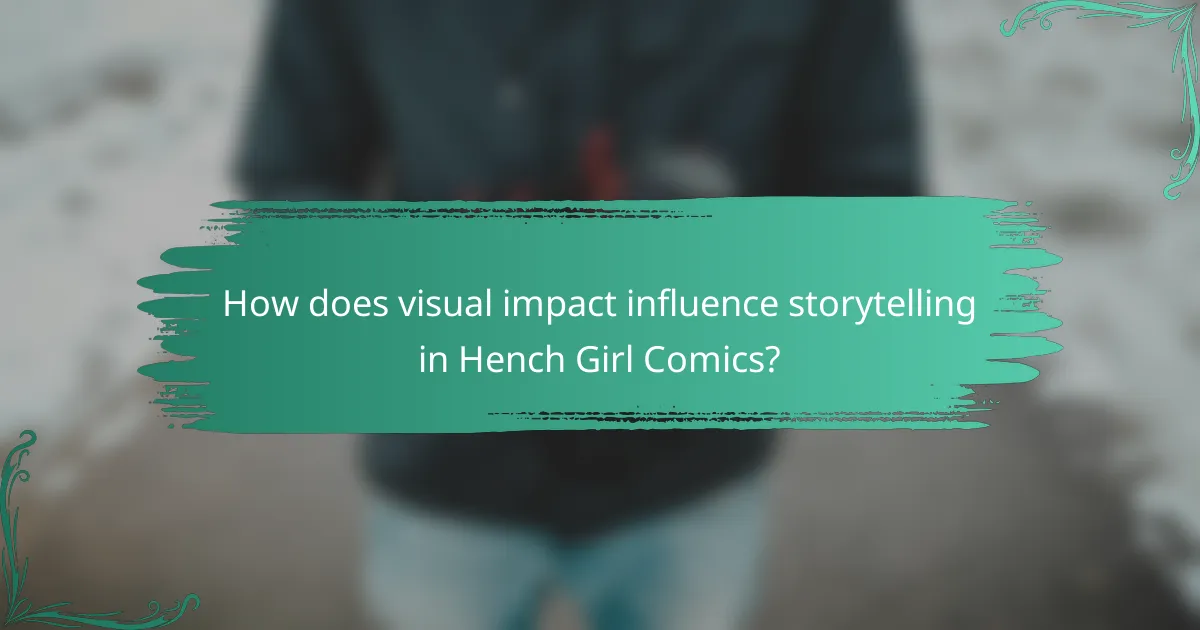
How does visual impact influence storytelling in Hench Girl Comics?
Visual impact plays a crucial role in storytelling within Hench Girl Comics by enhancing emotional engagement and guiding reader interpretation. Effective use of color schemes, character design, and panel layouts can significantly influence the mood and narrative flow, making the story more immersive and compelling.
Character design significance
Character design is vital in Hench Girl Comics as it conveys personality traits and emotional states at a glance. For instance, bold colors and exaggerated features can suggest a character’s strength or villainy, while softer tones might indicate vulnerability or innocence. This visual shorthand helps readers quickly grasp character dynamics.
When designing characters, consider the psychological effects of color. For example, red often symbolizes danger or passion, while blue can evoke calmness or sadness. Striking a balance between unique designs and recognizable archetypes can enhance relatability and depth.
Panel layout effects
The layout of panels in Hench Girl Comics directly impacts pacing and tension. A tightly packed arrangement can create a sense of urgency, while spacious panels allow for reflection and emotional weight. Varying panel sizes can also emphasize key moments or actions, guiding the reader’s focus effectively.
To optimize panel layouts, think about the flow of action and how it corresponds with the story’s rhythm. For example, using diagonal lines can suggest movement or chaos, while straight lines may convey stability. Experimenting with different layouts can help find the best way to enhance the narrative experience.
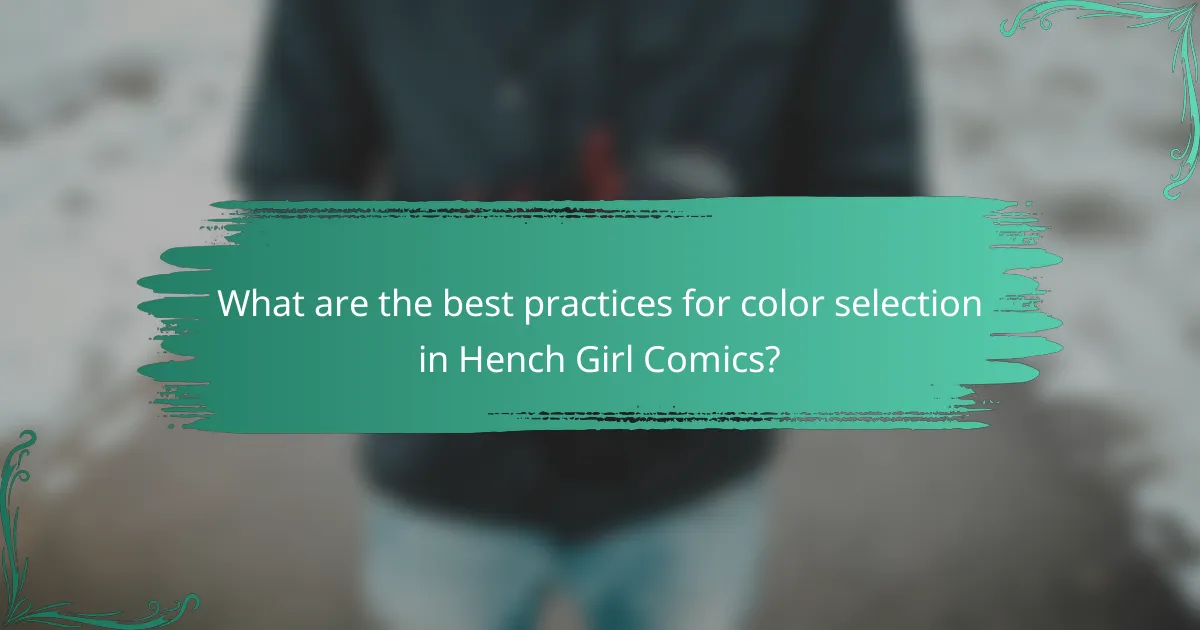
What are the best practices for color selection in Hench Girl Comics?
Effective color selection in Hench Girl Comics enhances storytelling and character development. Key practices include choosing a cohesive color palette, balancing colors for emotional impact, and ensuring visual clarity.
Choosing a color palette
When selecting a color palette for Hench Girl Comics, aim for a limited range of colors that complement each other. A palette typically consists of a primary color, secondary colors, and accent shades, which can evoke specific moods or themes. For instance, vibrant colors like reds and yellows can convey energy and action, while cooler tones like blues and greens may suggest calmness or mystery.
Consider using tools like Adobe Color or Coolors to explore different combinations and find inspiration. A good practice is to test your palette on a few character sketches to see how the colors interact in various contexts.
Balancing colors for impact
Balancing colors in Hench Girl Comics is crucial for creating visual interest and guiding the reader’s attention. Use contrasting colors to highlight important elements, such as a character’s costume or a significant action scene. For example, pairing a bright color with a muted tone can draw focus effectively.
Additionally, be mindful of color harmony; analogous colors (those next to each other on the color wheel) can create a pleasing effect, while complementary colors (opposite each other) can add drama. A common pitfall is overusing too many bright colors, which can overwhelm the reader. Aim for a balance that enhances the narrative without distracting from it.

What tools are used for color design in comics?
Color design in comics typically involves software tools that allow artists to create vibrant, engaging visuals. The most popular tools include Adobe Photoshop and Procreate, each offering unique features that cater to different aspects of color application and manipulation.
Adobe Photoshop features
Adobe Photoshop is renowned for its extensive color design capabilities, including a wide range of brushes, gradients, and blending modes. Artists can utilize layers to separate elements, making it easier to adjust colors without affecting the entire composition.
Key features include the Color Picker for precise color selection, adjustment layers for non-destructive editing, and the ability to create custom color palettes. These tools enable artists to experiment with various color schemes and moods effectively.
Procreate capabilities
Procreate offers a user-friendly interface with powerful color design tools optimized for touch devices. Its color wheel allows for quick selection and adjustment, while the Color Harmony feature helps artists explore complementary and analogous color schemes.
Procreate also supports layering and blending modes, similar to Photoshop, but with a focus on intuitive gestures. Artists can easily create dynamic color effects and apply textures, making it a popular choice for comic creators on the go.
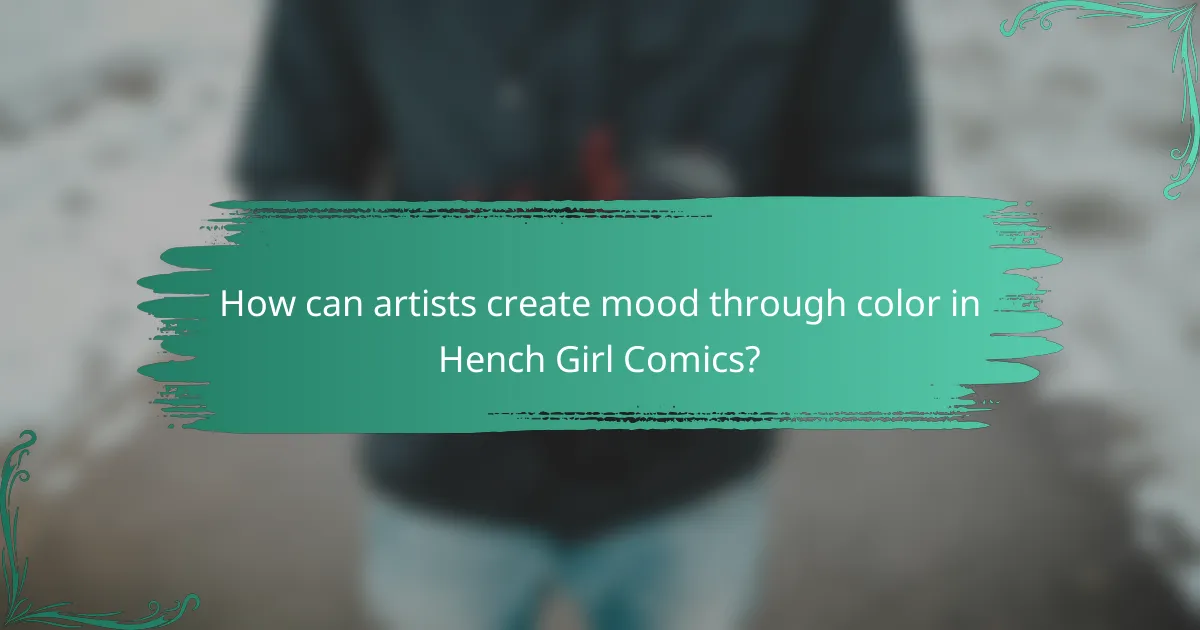
How can artists create mood through color in Hench Girl Comics?
Artists can evoke specific moods in Hench Girl Comics by carefully selecting and applying color schemes. The choice of colors influences the emotional tone and visual storytelling, making it essential for artists to understand how different hues and combinations affect the reader’s experience.
Color gradients for atmosphere
Color gradients can significantly enhance the atmosphere in Hench Girl Comics by creating depth and dimension. For instance, a gradient transitioning from dark blues to light purples can evoke a sense of mystery or tension, while warm gradients like reds and oranges can convey excitement or danger.
When using gradients, consider the context of the scene. A gradual shift from light to dark can symbolize a character’s emotional journey, while smooth transitions can help unify different elements on the page. Aim for subtlety; overly harsh gradients may distract rather than enhance.
Contrast for emotional depth
Contrast plays a crucial role in establishing emotional depth in Hench Girl Comics. High contrast between colors can draw attention to key elements, such as a character’s expression or a pivotal moment, while low contrast can create a more subdued, introspective atmosphere.
To effectively use contrast, pair complementary colors or use light and dark shades to highlight important features. For example, a bright red against a dark background can signify urgency or danger, while softer contrasts can evoke calmness or nostalgia. Be mindful of the overall color balance to maintain coherence in the visual narrative.
